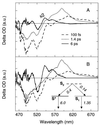An unusual pathway of excitation energy deactivation in carotenoids: singlet-to-triplet conversion on an ultrafast timescale in a photosynthetic antenna
- PMID: 11226245
- PMCID: PMC30144
- DOI: 10.1073/pnas.051501298
An unusual pathway of excitation energy deactivation in carotenoids: singlet-to-triplet conversion on an ultrafast timescale in a photosynthetic antenna
Abstract
Carotenoids are important biomolecules that are ubiquitous in nature and find widespread application in medicine. In photosynthesis, they have a large role in light harvesting (LH) and photoprotection. They exert their LH function by donating their excited singlet state to nearby (bacterio)chlorophyll molecules. In photosynthetic bacteria, the efficiency of this energy transfer process can be as low as 30%. Here, we present evidence that an unusual pathway of excited state relaxation in carotenoids underlies this poor LH function, by which carotenoid triplet states are generated directly from carotenoid singlet states. This pathway, operative on a femtosecond and picosecond timescale, involves an intermediate state, which we identify as a new, hitherto uncharacterized carotenoid singlet excited state. In LH complex-bound carotenoids, this state is the precursor on the reaction pathway to the triplet state, whereas in extracted carotenoids in solution, this state returns to the singlet ground state without forming any triplets. We discuss the possible identity of this excited state and argue that fission of the singlet state into a pair of triplet states on individual carotenoid molecules constitutes the mechanism by which the triplets are generated. This is, to our knowledge, the first ever direct observation of a singlet-to-triplet conversion process on an ultrafast timescale in a photosynthetic antenna.
Figures





References
-
- Koyama Y, Hashimoto H. In: Carotenoids in Photosynthesis. Young A, Britton G, editors. London: Chapmann & Hall; 1993. pp. 327–409.
-
- Koyama Y, Kuki M, Andersson P O, Gillbro T. Photochem Photobiol. 1995;63:243–256.
-
- van Grondelle R, Dekker J P, Gillbro T, Sundstrom V. Biochim Biophys Acta. 1994;1187:1–65.
-
- Duysens L N M. Ph.D. thesis. Utrecht, The Netherlands: University of Utrecht; 1952.
-
- Rademaker H, Hoff A J, van Grondelle R, Duysens L N M. Biochim Biophys Acta. 1980;592:240–257. - PubMed
Publication types
MeSH terms
Substances
LinkOut - more resources
Full Text Sources
Other Literature Sources

